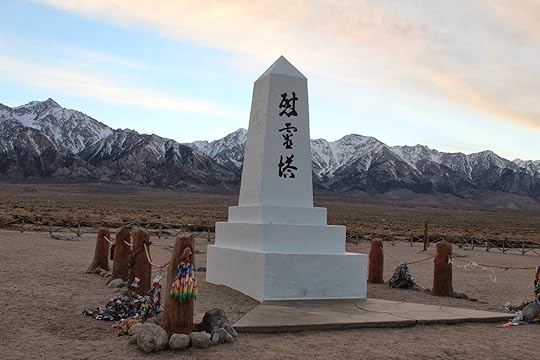Musings from the Mojave: Ridgecrest, Lone Pine, and Manzanar

Ever hear of Ridgecrest? It’s a small, friendly town in the Upper Mojave Desert, 2 ½ hours and a world away from Los Angeles. Still, Ridgecrest is glad to be considered an outpost of Movieland.
Last week I spent several days in Ridgecrest, as guest of the East Sierra Branch of the California Writers Club. The pleasant, attentive people to whom I spoke – many of them authors themselves – seemed fascinated by my stories about what it took to write, publish, and promote my Roger Corman: Blood-Sucking Vampires, Flesh-Eating Cockroaches, and Driller Killers. Ridge Writers, as they call themselves, have had their share of Hollywood experiences. Among the movies filmed in their desert community are Jurassic Park, Holes, Tremors, and Land of the Lost.
Up the road a piece from Ridgecrest is Lone Pine, population 2,035. It’s at a higher elevation than Ridgecrest (3,727 feet, to be exact), and its location – nestled against the rugged Alabama Hills, which abut the eastern slope of the Sierra Nevadas – makes it particularly picturesque. Which means, of course, that Hollywood discovered it long ago. Since the days of silent movies, Lone Pine has been the location of choice for shooting cowboy movies. Every he-man from Gary Cooper to Clark Gable to Humphrey Bogart has strapped on his six-guns in this vicinity. It’s also been the locale where Roy Rogers and William “Hopalong Cassidy” Boyd filmed most of their western adventures, and where the Lone Ranger roamed, with the faithful Tonto in tow.
Which is why Lone Pine boasts a dandy little attraction. Avid collectors Beverly and Jim Rogers display their collection of western memorabilia in Lone Pine’s Film History Museum, which bills itself as the place “where the real west becomes the reel west.” Visitors generally start out watching a short documentary, which reveals that in the days before overseas location shooting, the region also supplied exotic desert terrain for Gunga Din and The Lives of a Bengal Lancer. But the doc’s real focus, of course, is on westerns, and we learn that the town’s citizenry often helped out by supplying horses and props. At the fadeout, we hear the Statler Brothers singing their ode to a vanishing breed, “Whatever Happened to Randolph Scott?”
Among the museum’s treasures are a case devoted to movie bad guys and a fascinating assortment of gear worn by the late stuntman Richard Farnsworth. (You can see a protective vest made for a guy who’s stuck being struck by an arrow, and another used by someone who needs to be dragged by a galloping horse.) The eldest of Roy Rogers’ nine children has contributed a slide show of family photos. Though the autographed celebrity headshots on the walls of the town’s best restaurant are mostly quite dated (Dale Evans, Ernest Borgnine, Sally Struthers), I also discovered that as a filming location Lone Pine has not yet gone out of style. Bits of Iron Man were shot here, along with Gladiator and Star Wars. Only two years ago, Quentin Tarantino brought some of his cast to Lone Pine for Django Unchained.
But to me the most remarkable location is to be found a few miles further north. Manzanar was once a “relocation” camp where 11,000 Japanese Americans were incarcerated by their own government from 1942 to 1945. Today, it’s being preserved as a national monument. For visitors it’s an eerie place, especially at sunset, when the wind blows lonesome and the old Japanese cemetery stands out starkly against the Sierras. Lest we forget the cruelties of which we as a people are capable, someone really needs to make a great movie.

Published on March 14, 2014 10:27
No comments have been added yet.
Beverly in Movieland
I write twice weekly, covering topics relating to movies, moviemaking, and growing up Hollywood-adjacent. I believe that movies can change lives, and I'm always happy to hear from readers who'd like t
I write twice weekly, covering topics relating to movies, moviemaking, and growing up Hollywood-adjacent. I believe that movies can change lives, and I'm always happy to hear from readers who'd like to discuss that point.
...more
- Beverly Gray's profile
- 10 followers



